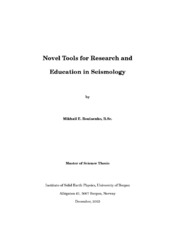| dc.contributor.author | Boulaenko, Mikhail E. | eng |
| dc.date.accessioned | 2006-08-10T12:48:05Z | |
| dc.date.available | 2006-08-10T12:48:05Z | |
| dc.date.issued | 2002 | eng |
| dc.identifier.isbn | 82-8088-107-7 (electronic version) | en_US |
| dc.identifier.uri | https://hdl.handle.net/1956/1708 | |
| dc.description.abstract | It’s first part describes the noise performances of an inexpensive instrument for seismic data collection; the geophone-based seismograph used in the SEIS-SCHOOL network and now called Cossac Ranger. The analysis of its properties such as the transfer function and the thermal stability is given. A theoretical model for the instrumental noise calculation is proposed and then the instrumental noise RMS spectral density curves are calculated. Based on the obtained noise level it is concluded that the performance of the geophone-based seismograph is comparable to that of a standard short period seismometer. Further, it was found that the instrumental noise at frequencies below 10Hz is mainly generated by the operational amplifier circuits. According to the above analysis three alternative preamplifier design solutions were proposed and analyzed. One of them showed better noise performances then those of the original design. The new design also forwards a simplification of the assembling process of the preamplifier. In Appendix A a set of equations for a geophone transfer function and impedance is developed. Appendix B presents theory of operation of the over-damping preamplifier. A theoretical model for calculation of the instrumental noise of the preamplifier is highlighted in Appendix C. The second part of the thesis is devoted to electronic learning technologies. It highlights the conceptual design of the SEIS-SCHOOL project e-learning modules and gives a brief description of its practical application. It starts with an overview of available Web-technologies for creation of advanced electronic learning modules. Then demonstrates that such technologies and freeware suffice for creation of such modules. Important here is that costly commercial software is not needed for compliance to high-level e-learning standards regarding modules accessibility, durability, interoperability, and content reusability. The third part describes the content of the e-modules being created for high school students, as well as a description of the first of these e-modules. An overview of the basic design principles is given. The software package for the interactive seismicity mapping and statistical catalog analysis “SEISMOTECTONICS” used as a practical task in the e-learning framework is also presented. | en_US |
| dc.format.extent | 2430807 bytes | eng |
| dc.format.mimetype | application/pdf | eng |
| dc.language.iso | eng | eng |
| dc.publisher | The University of Bergen | en_US |
| dc.title | Novel Tools for Research and Education in Seismology | en_US |
| dc.type | Master thesis | |
| dc.rights.holder | The author | en_US |
| dc.rights.holder | Copyright the author. All rights reserved | en_US |
| dc.subject.nsi | VDP::Matematikk og Naturvitenskap: 400::Geofag: 450::Andre geofag: 469 | nob |
